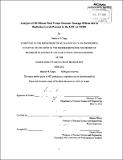Analysis of 3D silicon pixel vertex detector damage effects due to radiation levels present in the LHC at CERN
Author(s)
Chapa, Matthew R
DownloadFull printable version (7.500Mb)
Alternative title
Analysis of 3D silicon pixel vertex detector damage effects due to radiation levels present in the Large Hadron Collider at CERN
Other Contributors
European Organization for Nuclear Research.
Advisor
Dennis Whyte.
Terms of use
Metadata
Show full item recordAbstract
In high energy physics experiments, very high precision tracking of charged particles is needed. Solid state detectors achieve the high precision necessary to provide track and vertex reconstruction of the particles that traverse them, but tracking performance begins to deteriorate at fluxes of radiation around 10¹⁴ - 10¹⁵ hadrons/cm 2. These radiation levels are congruent with those experienced by the ATLAS pixel detector, the inner most part of the ATLAS tracking system, which is vital to track and vertex reconstruction. During the planned shut-down of the Large Hadron Collider (LHC) in 2013-2014, the energy and luminosity of the LHC will both be increased. The current pixel detector has begun to suffer deterioration of performance, so the ATLAS Collaboration has initiated an upgrade to take place during the scheduled shut-down beginning in 2013, the Insertable B-Layer (IBL). The IBL will be assembled and placed in between a reduced diameter beam pipe and the current pixel detector, acting as the fourth layer of the ATLAS inner detector. The pixel sensors of the IBL will have to sustain a radiation dose of 5 * 10¹⁵neq/cm². Two sensor technologies are being considered for the IBL upgrade: planar n-in-p silicon pixel sensors and 3D double sided n-in-p pixel sensors. Research of both these technologies is being done by the IFAE in collaboration with CNM-Barcelona. To cope with the increased data rate after the LHC upgrade, a new front-end chip has also been produced, the FE-14 front-end chip. Test results and data analysis from five different 3D pixel sensor devices, all fabricated at CNM-Barcelona were done. Evaluation of these technologies and the test results of irradiated 3D pixel sensor devices are carried out in this thesis.
Description
Thesis (S.B.)--Massachusetts Institute of Technology, Dept. of Nuclear Science and Engineering, 2012. "June 2012." Cataloged from PDF version of thesis. Includes bibliographical references (p. 45).
Date issued
2012Department
Massachusetts Institute of Technology. Department of Nuclear Science and EngineeringPublisher
Massachusetts Institute of Technology
Keywords
Nuclear Science and Engineering., European Organization for Nuclear Research.